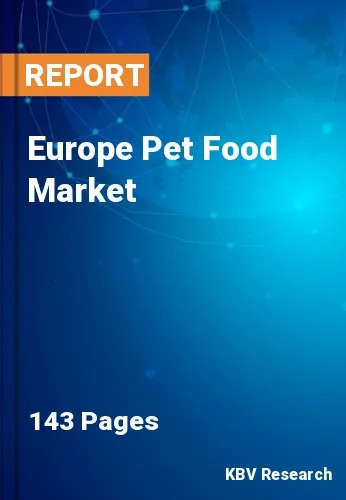The Europe Pet Food Market would witness market growth of 4.6% CAGR during the forecast period (2023-2030). In the year 2020, the Europe market's volume surged to 3,862.4 Kilo Tonnes, showcasing a growth of 4.6% (2019-2022).
Changing family structures, including smaller families, and increasing single-person households, have contributed to pet ownership. Smaller companion animals are often preferred in these households. As human health and wellness trends influence pet owners, pet food companies are developing products that align with these trends. For example, pet foods with natural, organic, gluten-free, or low-allergen ingredients are becoming more prevalent in response to consumer demands. Health-conscious pet owners prioritize pet food made from high-quality, natural ingredients. They prefer products that do not contain artificial additives, preservatives, or fillers, leading to a demand for premium pet food options.
Pet owners are more educated about pet nutrition and the specific dietary needs of their pets. They actively seek pet food products that meet these needs, providing the essential nutrients for their animals. Veterinary professionals play a crucial role in educating pet owners about pet nutrition. Many pet owners consult with veterinarians to ensure they provide the best nutrition for their pets, especially those with specific health conditions. The demand for holistic and organic pet food has grown, driven by the desire to provide pets with natural and wholesome nutrition. These products are perceived as healthier choices.
According to the European Pet Food Federation's (FEDIAF) most current yearly data from 2022, there are approximately 340 million pets in Europe, with 91 million homes (or 46%) having one or more animals. There are about 104 million dogs and 127 million cats. It indicates that pet ownership in Europe remains high. The market continues to experience growth in the pet care sector in this region due to the rise in pet adoption rates and the humanization of pets. Spain has pet-friendly policies that encourage pet owners to bring their pets to various places, such as restaurants and parks, further reinforcing the importance of pet nutrition. All these factors will uplift the regional market’s expansion in coming years.
The Germany market dominated the Europe Pet Food Market, by Country in 2022, and would continue to be a dominant market till 2030; thereby, achieving a market value of $8,503.5 Million by 2030. The UK market is exhibiting a CAGR of 3.6% during (2023 - 2030). Additionally, The France market would experience a CAGR of 5.4% during (2023 - 2030).
Based on Food Type, the market is segmented into Dry Food, Wet Food, Treats & Snacks, and Others. Based on Sales Channel, the market is segmented into Specialized Pet Shops, Supermarkets & Hypermarkets, Online Sales Channel, and Others. Based on Pet Type, the market is segmented into Dog, Cat and Others. Based on countries, the market is segmented into Germany, UK, France, Russia, Spain, Italy, and Rest of Europe.
Free Valuable Insights: The Global Pet Food Market will Hit $138.8 Billion by 2030, at a CAGR of 4.8%
The market research report covers the analysis of key stakeholders of the market. Key companies profiled in the report include Unicharm Corporation (DSG International (Thailand) PLC), Farmina Pet Foods Holding B.V., Nestle S.A., General Mills, Inc., Mars, Inc. (Kind LLC), The Colgate Palmolive Company, The Wellness Pet Company (Clearlake Capital Group, L.P.), Schell & Kampeter, Inc., Archer Daniels Midland Company, and Thai Union Group PLC
By Food Type (Volume, Kilo Tonnes, USD Million, 2019-2030)
By Sales Channel (Volume, Kilo Tonnes, USD Million, 2019-2030)
By Pet Type (Volume, Kilo Tonnes, USD Million, 2019-2030)
By Country (Volume, Kilo Tonnes, USD Million, 2019-2030)
Our team of dedicated experts can provide you with attractive expansion opportunities for your business.

